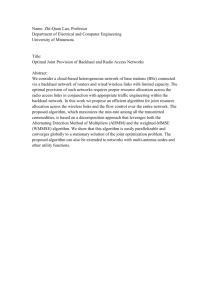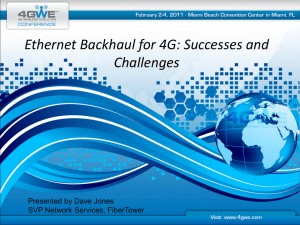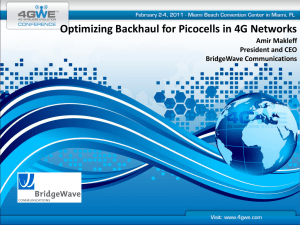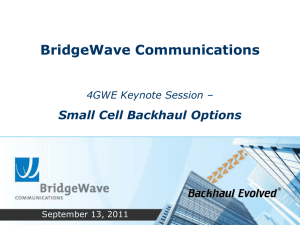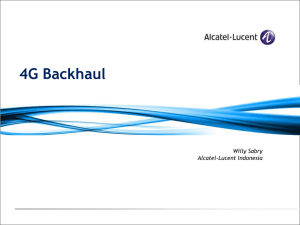Wireless LTE Deployment Changing Cell Site Energy
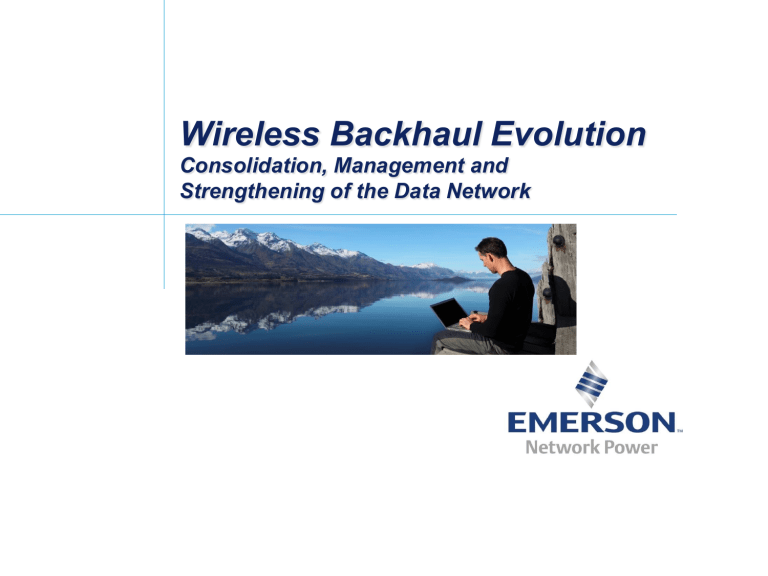
Wireless Backhaul Evolution
Consolidation, Management and
Strengthening of the Data Network
Introduction
Backhaul: Once the “ after thought ” of the wireless infrastructure
Explosive amounts of data back through the wireless infrastructure in the last (5) years
4G and LTE are pushing the boundaries of the existing network
Now considered an essential element of the network:
The New Wireless Cash Cow?
Standard T1 copper network unable to meet the new topology
Wireless backhaul is essential to today ’s network
2
© Emerson Electric Co.; Proprietary Information
Evolution of Wireless Backhaul
Initial providers only focused on voice
As network speed evolved (LTE), data became the primary driver
Large data streams brought greater demands on wireless backhaul
20% of copper backhaul is overburdened; rising to 50% by 2015
Today ’s copper T1 backhaul can handle a maximum of 1.5 to 2 Mbps
Wireless backhaul needs to meet the ever growing network requirements of today
3
© Emerson Electric Co.; Proprietary Information
Wireless Market Evolution
Consumer Needs
Greater mobile flexibility through voice, text, email and video
Faster data speeds for mobile applications
Service Provider Needs
Lower infrastructure costs
High speed radio systems
Ethernet and microwave backhaul compatibility
VoIP
OEM
Consumer
DATA
Provider
The wireless infrastructure is data centric
4
© Emerson Electric Co.; Proprietary Information
Mobile Data Replaces Fixed Data
Broadband subscribers to reach 3.4 billion by 2014
80% of the users will be mobile based
Fixed broadband growth expected to remain near static
Service providers are being driven by (2) distinct trends
Increase in smart mobile devices
Data centric applications
4G networks in North America will increase data traffic 26 fold from 2010 through 2015
5
© Emerson Electric Co.; Proprietary Information
Wireless Backhaul Market Drivers
Cell Site Growth
Approximately 300,000 sites in the US
Expected to grow to 430,000 by 2015 in the US
Smart Phone Impact
Smart phones account for 15% of the market share today, but they account for 78% of the data traffic
In 2010 over 3 million tablets were connected to the network generating five times as much data as smart phones
Migration towards LTE (Long Term Evolution – 4G)
Speeds increasing from ~3Mbps to 20-100Mbps
Bandwidth increasing from ~20MHz to 100MHz
6
© Emerson Electric Co.; Proprietary Information
Wireless Backhaul 101
Access Network
Handset,
PDA or Laptop
Copper
Fiber
Carrier Base Station
Public Switched
Telephone Network
Mobile Switching Office
(provisioning, call routing, etc)
Source: Fibertower Investor Presentation, April 2008.
Three Main Transport Methods
Copper (T1s)
Fiber
Microwave
Copper/Fiber Hybrid Solution
Copper – TDM great for voice, not so great for data
Fiber – Ethernet great for data, allows transition to VOIP
7
© Emerson Electric Co.; Proprietary Information
Wireless Backhaul Infrastructure Trends
Fiber quickly replacing copper to meet LTE bandwidth requirements
Point-to-point microwave backhauled to fiber to save cost
Ethernet over T1 driving savings, greater data flow and greater reliability
8
© Emerson Electric Co.; Proprietary Information
Backhaul Transport Comparisons
Copper
(T1s)
Capex
Deployment
Speed
Opex/
Mbps
Technical
Flexibility
Usage/
Trend
End-User
‘ Experience ’
US ~75%
ROW ~15%
Fiber
US ~15%
ROW ~25%
US ~10%
ROW ~60%
Microwave
9
© Emerson Electric Co.; Proprietary Information
The Dark Side of Backhaul
Revenues may not keep pace with data surges through the wireless network
Cost to deliver a “ byte ” of data will exceed generated revenue by early 2013
Top two service providers are laying fiber to the majority of their edge midstream networks
Lower tier suppliers may choose NOT to upgrade the backhaul infrastructure
Cost to enter may cause a “ wait and see ” approach
Risk of increased rate of churn
Small regional/rural service providers may gain access to low interest loans and funding via government broadband initiative
10
© Emerson Electric Co.; Proprietary Information
Backhaul Technology Comparison
Microwave Fiber lines
Capacity · Up to several Gbps · Unlimited
Regulation
Distance influence on costs and deployment time
· Requires spectrum
· Visual impact considerations
· Cost per link with some incremental cost with the distance
· Fast deployment time
Terrain
Reuse options
Climate
· Requires right of ways and infrastructures; renovation construction works after trenching
· Costs increase per feet/meter
· Deployment time increases linearly with distance
· Suitable for any terrain
· Requires line-of-sight between two link end-points
· Equipment can be disassembled and relocated somewhere else
· Influenced by climate
· Adaptive modulation and a proper link planning reduces climate effects
· Becomes costly when trenching in difficult terrain
(mountains, deserts, swamps, rocky plains or jungles)
· Accessibility - requires access for vehicles along the trenching path
· Fiber, in most cases, cannot be relocated
· Copper ducts may be reused for fiber lines
· Normally, not influenced, except for floods
Source: Ceragon Networks Ltd. Mobile Backhaul: Fiber vs. Microwave, October 2009.
11
© Emerson Electric Co.; Proprietary Information
Backhaul Technology Cost Comparison
12
© Emerson Electric Co.; Proprietary Information
Conclusions
Data has become the dominant mobile transmission vehicle of backhaul topology
Transition to LTE and VOIP will only increase the burden on the backhaul network
Providers that securely manage data in their networks will be financially successful long term
The wireless backhaul network will be defined by:
Speed
$$$ (short and long term)
Terrain
Climate
13
© Emerson Electric Co.; Proprietary Information
Questions?
Contact:
Paul Misar
Director, OSP Cabinet Solutions
Paul.Misar@Emerson.com
Don ’t forget to visit us online at:
EmersonNetworkPower.com/EnergySystems
14
© Emerson Electric Co.; Proprietary Information
